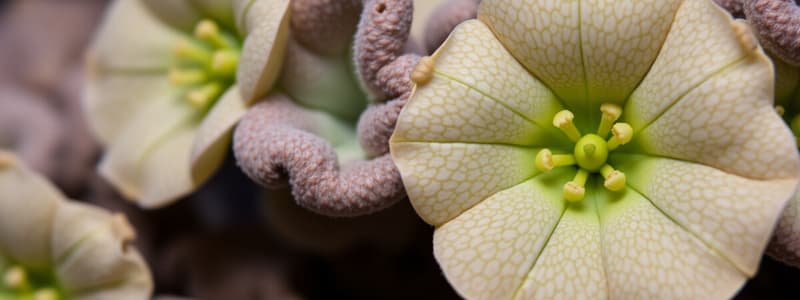Podcast
Questions and Answers
What is classification?
What is classification?
- The process of grouping living things based on their similarities (correct)
- A method for predicting the weather
- The study of animal behavior
- The process of designing experiments
Why do scientists classify?
Why do scientists classify?
They want to organize living things into groups so that they are easier to study.
What is taxonomy?
What is taxonomy?
The scientific study of how living things are classified.
What did Linnaeus base his classification on?
What did Linnaeus base his classification on?
What is binomial nomenclature?
What is binomial nomenclature?
What does an organism's genus represent?
What does an organism's genus represent?
What is a genus?
What is a genus?
What defines a species?
What defines a species?
What is the advantage of scientific names?
What is the advantage of scientific names?
What are the eight levels of classification from broadest to narrowest?
What are the eight levels of classification from broadest to narrowest?
What are the eight levels of classification from narrowest to broadest?
What are the eight levels of classification from narrowest to broadest?
Which level of classification has the most different kinds of organisms?
Which level of classification has the most different kinds of organisms?
Which level of classification has the fewest different kinds of organisms?
Which level of classification has the fewest different kinds of organisms?
What are field guides?
What are field guides?
What are taxonomic keys?
What are taxonomic keys?
What is evolution?
What is evolution?
How is knowing a species' evolutionary history important to its classification?
How is knowing a species' evolutionary history important to its classification?
What do scientists today primarily rely on to determine evolutionary history?
What do scientists today primarily rely on to determine evolutionary history?
What could happen to an organism's classification if scientists find new chemical information relating to that organism?
What could happen to an organism's classification if scientists find new chemical information relating to that organism?
Study Notes
Classification of Living Things
- Classification groups living organisms based on similarities for easier study.
- Taxonomy is the scientific study of how living things are classified.
Purpose of Classification
- Organizing living things helps scientists communicate effectively about organisms.
- The system of naming organisms is known as binomial nomenclature, developed by Linnaeus.
Linnaeus's Classification
- Organisms are grouped according to observable features.
- Each organism's scientific name consists of two parts: the genus and species.
Levels of Classification
- Classification hierarchy ranges from broadest to narrowest: domain, kingdom, phylum, class, order, family, genus, species.
- The domain level contains the most diverse organisms, while the species level has the fewest kinds of organisms.
Tools for Classification
- Field guides provide illustrations to differentiate similar organisms.
- Taxonomic keys consist of paired statements detailing physical characteristics of organisms.
Evolution and Classification
- Evolution describes the gradual change in species over time.
- Understanding a species' evolutionary history is crucial for classification, as similar evolutionary traits indicate a common ancestor.
- Modern classification often relies on the chemical composition of an organism's cells to determine relationships.
Implications of New Discoveries
- New chemical information can lead to the reclassification of an organism if necessary.
Studying That Suits You
Use AI to generate personalized quizzes and flashcards to suit your learning preferences.
Description
This set of flashcards explores the essential concepts of biological classification. Learn about taxonomy, the reasons scientists classify living things, and the notable contributions of Linnaeus in organizing life forms. Perfect for students aiming to grasp the basics of biological classification.




